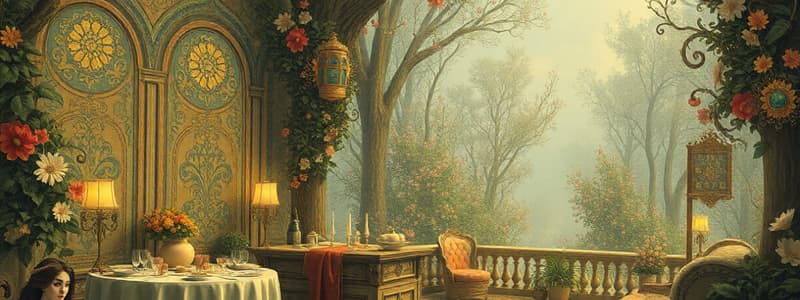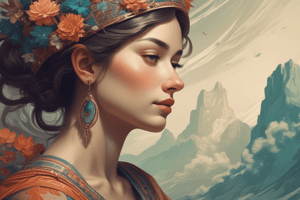Podcast
Questions and Answers
Which of the following mediums is NOT categorized as art?
Which of the following mediums is NOT categorized as art?
- Painting
- Music
- Sculpture
- Car Repair (correct)
Art primarily conveys emotions and ideas.
Art primarily conveys emotions and ideas.
True (A)
Name one art movement that challenged established norms.
Name one art movement that challenged established norms.
Cubism
____________ involves creating three-dimensional forms using materials like stone, metal, or clay.
____________ involves creating three-dimensional forms using materials like stone, metal, or clay.
Match the following art movements with their defining characteristics:
Match the following art movements with their defining characteristics:
What is a key aspect of defining art?
What is a key aspect of defining art?
All art forms have a defined and universally accepted purpose.
All art forms have a defined and universally accepted purpose.
List one factor that influences artistic expression.
List one factor that influences artistic expression.
Artistic expression often reflects cultural __________.
Artistic expression often reflects cultural __________.
Which of the following is a type of art that uses sound?
Which of the following is a type of art that uses sound?
Flashcards
What is Art?
What is Art?
A broad field that includes creative activities like painting, sculpture, music, and literature. It often reflects cultural values and beliefs.
Is there one definition of art?
Is there one definition of art?
Art is a complex concept with no single, universally accepted definition. Different cultures and time periods have their own interpretations.
What is Art History?
What is Art History?
It's the study of how art has changed and developed throughout history, from prehistoric cave paintings to modern art.
What are Art Movements?
What are Art Movements?
Signup and view all the flashcards
What are key aspects of creating art?
What are key aspects of creating art?
Signup and view all the flashcards
What is painting?
What is painting?
Signup and view all the flashcards
What is sculpture?
What is sculpture?
Signup and view all the flashcards
What is architecture?
What is architecture?
Signup and view all the flashcards
What is music?
What is music?
Signup and view all the flashcards
What is dance?
What is dance?
Signup and view all the flashcards
Study Notes
Introduction to Art
- Art encompasses a wide range of human creative activities and their products, involving aesthetics, skill, and technique.
- It spans various mediums, including painting, sculpture, architecture, music, dance, literature, film, and photography.
- Art often reflects cultural values, beliefs, and historical contexts.
- Artistic expression can communicate emotions, ideas, and experiences.
Defining Art
- Defining art is complex and subjective, with varying interpretations across cultures and time periods.
- Some approaches focus on the artist's intent, while others emphasize the observer's response.
- Aesthetics, the appreciation of beauty, plays a significant role in many art forms.
- There's no single universally accepted definition of art.
History of Art
- Art history traces artistic developments across numerous periods and civilizations, from prehistoric cave paintings to modern installations.
- Different styles and movements emerged, each reflecting specific historical and cultural contexts.
- Examples include Renaissance art, Baroque art, Impressionism, Post-Impressionism, and others, each with unique characteristics and themes.
- Art practices have evolved significantly, constantly challenging norms and standards.
Art Movements
- Important art movements often challenged established norms and conventions.
- These movements explored new styles, techniques, subject matters, and meanings, challenging the status quo.
- Examples include Cubism, Surrealism, and Pop Art.
- Each movement often incorporated unique characteristics.
Aspects of Art Creation
- Creativity and imagination are core to artistic production.
- Technical skill and mastery of materials are essential to bring ideas to life.
- Artists often incorporate elements of composition, perspective, and color to achieve a desired effect.
- Artistic ideas can be a reflection of personal experiences and perspectives.
Types of Art
- Painting involves using pigments on a surface, such as canvas or paper.
- Sculpture involves creating three-dimensional forms using various materials like stone, metal, or clay.
- Architecture involves planning, designing, and constructing buildings.
- Music uses sound to create patterns and emotions.
- Dance involves expressive movement.
- Literature encompasses written works like poetry, novels, and plays.
- Film combines visual images and sound to tell stories.
- Photography captures images using light and sensitive materials.
Function of Art
- Art functions are diverse and can include aesthetic enjoyment, social commentary, political statements, or spiritual expression.
- Art can represent everyday life, as well as explore the extraordinary.
- It can educate, inspire, entertain, and challenge perceptions.
- Art's ability to evoke emotion distinguishes it from purely functional objects.
Studying That Suits You
Use AI to generate personalized quizzes and flashcards to suit your learning preferences.



